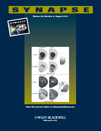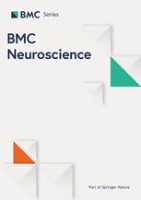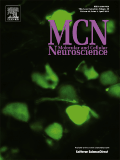
SYNAPSE
Scope & Guideline
Pioneering Research in Cellular and Molecular Neuroscience
Introduction
Aims and Scopes
- Neuropharmacology and Drug Action:
Research examining the effects of pharmacological agents on neural activity, synaptic transmission, and behavior, often exploring therapeutic potentials for various neurological conditions. - Mechanisms of Synaptic Plasticity:
Studies that delve into the cellular and molecular mechanisms underlying synaptic changes associated with learning, memory, and neurological diseases. - Neurodevelopment and Age-related Changes:
Investigations focused on how developmental processes and aging affect neural structure and function, including the impact of external factors. - Neurodegeneration and Disease Models:
Research utilizing animal models to study the mechanisms of neurodegenerative diseases, aiming to uncover potential interventions or therapeutic strategies. - Behavioral Neuroscience:
Exploration of the relationship between neural processes and behavior, including studies on anxiety, addiction, and cognitive functions.
Trending and Emerging
- Neuroinflammation and Neurodegenerative Disease:
A growing emphasis on the role of neuroinflammation in conditions like Alzheimer's disease and other neurodegenerative disorders reflects a trend towards understanding the immune response in the brain. - Molecular Mechanisms of Synaptic Function:
Research on specific molecular pathways and their role in synaptic function and plasticity is gaining traction, emphasizing the importance of detailed biochemical analyses. - Translational Research and Therapeutic Approaches:
There is an increasing focus on translating basic neuroscience findings into potential therapeutic strategies for neurological disorders, bridging the gap between bench and bedside. - Impact of Environmental Factors on Neural Function:
Emerging studies explore how environmental variables, such as stressors or dietary components, influence brain function and behavior, highlighting the interplay between environment and neurobiology. - Sex Differences in Neuroscience:
Research addressing gender-related differences in neural function and responses to pharmacological treatments is on the rise, reflecting a broader recognition of the importance of sex as a biological variable.
Declining or Waning
- Traditional Neuroanatomy:
Research centered around classical neuroanatomical descriptions and mappings appears to be less frequent, suggesting a move towards more functional and molecular studies. - Basic Electrophysiology:
Papers focusing solely on basic electrophysiological measurements without integrating them into broader behavioral or pharmacological contexts are becoming less common. - Age-specific Studies without Broader Context:
Investigations that focus purely on age-related changes without linking them to neuroplasticity or therapeutic implications are diminishing in favor of more integrative approaches.
Similar Journals

BMC NEUROSCIENCE
Pioneering Research for a Deeper Understanding of the BrainBMC NEUROSCIENCE is a prominent open access journal dedicated to the dissemination of high-quality research within the dynamic and rapidly evolving field of neuroscience. Published by BMC, a well-respected leader in open access publishing, this journal facilitates the free exchange of knowledge since its inception in 2000. With the ISSN 1471-2202, BMC NEUROSCIENCE aims to address the diverse interests of the neuroscience community by covering a broad spectrum of topics, ranging from cellular and molecular neuroscience to general neurological studies, thus appealing to researchers, professionals, and students alike. Although it currently holds a Q4 ranking in Cellular and Molecular Neuroscience and a Q3 rank in miscellaneous Neuroscience categories, its commitment to advancing the understanding of brain function and disorders remains steadfast. The journal features a user-friendly Open Access model, ensuring that critical research findings are readily accessible to everyone, fostering collaboration and innovation in the field. As the journal continues to evolve towards its convergence years of 2024, it aspires to enhance its impact and global reach, making it a valuable resource for anyone interested in advancing neuroscience research.

NEUROSCIENCE
Navigating the intricate landscape of the brain.NEUROSCIENCE, published by PERGAMON-ELSEVIER SCIENCE LTD, has established itself as a reputable journal in the field of neuroscience since its inception in 1976, continuing its contributions through 2024. With a Category Quartile ranking of Q2 in Neuroscience (miscellaneous) and a Scopus Rank of #41 out of 113, this journal represents a critical platform for the dissemination of innovative research and insights. Although it currently does not offer open access options, NEUROSCIENCE aims to advance our understanding of the nervous system by publishing high-quality original research, reviews, and methodological articles, thereby engaging a comprehensive audience of researchers, professionals, and students alike. With an impact factor that reflects its significance in the scientific community, this journal remains a go-to source for cutting-edge discoveries and scholarly discussions in the dynamic field of neuroscience.

Eneurobiologia
Bridging Research and Application in NeurobiologyEneurobiologia is an esteemed open-access journal published by UNIV VERACRUZANA, INST INVESTIGACIONES & EDUCACION, dedicated to advancing research in the vibrant field of neurobiology. With its launch in 2010, the journal aims to disseminate high-quality, peer-reviewed research articles that explore the complexities of neural systems, neurodevelopment, and neurodegenerative disorders. By providing a platform for both established researchers and emerging scholars, Eneurobiologia fosters interdisciplinary collaboration and knowledge exchange within the scientific community. Its open-access model ensures that valuable findings are accessible to a global audience, promoting the widespread application of neurobiological research. As a crucial resource for students, professionals, and researchers alike, Eneurobiologia plays a pivotal role in shaping the future of neurobiological studies and enhancing our understanding of the brain and nervous system.

Neuroscience Bulletin
Fostering collaboration in the realm of neuroscience.Neuroscience Bulletin is a prestigious academic journal published by SPRINGER, focusing on the dynamic and interdisciplinary field of neuroscience. Established in 2005, this journal has consistently provided a platform for groundbreaking research, showcasing contributions that span various aspects of neuroscience, physiology, and medicine. With an admirable impact factor and recognition as a Q1 journal in both Medicine and Neuroscience categories for 2023, it ranks highly in the Scopus metrics, reflecting its importance in advancing scientific knowledge and practice. Researchers and professionals alike benefit from its cutting-edge articles, which are accessible through traditional subscription models. The Neuroscience Bulletin plays a crucial role in disseminating significant findings and fostering collaboration within the global research community, making it an essential resource for anyone engaged in the exploration of neural mechanisms, treatments, and innovations.

Science Bulletin
Exploring the frontiers of multidisciplinary research.Science Bulletin is a premier multidisciplinary journal published by Elsevier, renowned for its commitment to advancing scientific knowledge across various fields. With an impressive impact factor and achieving a distinguished Q1 category ranking in 2023 within its multidisciplinary scope, Science Bulletin stands out for its rigorous peer-review process and high-quality research dissemination. Since its inception in 2015, the journal has been pivotal in bridging gaps between diverse scientific disciplines, fostering collaboration and innovation. Researchers and professionals can benefit from its Open Access options, ensuring wider visibility and accessibility of groundbreaking research. With a Scopus rank of #4 out of 171, placing it in the 97th percentile, Science Bulletin continues to set the standard for scholarly excellence, making it an essential resource for those seeking to stay at the forefront of scientific discovery.

CEREBRAL CORTEX
Advancing knowledge in cortical neuroscience.CEREBRAL CORTEX, published by Oxford University Press Inc, is a premier journal dedicated to advancing the field of neuroscience, specifically focusing on the cellular, molecular, and cognitive aspects of cortical structure and function. With an impressive impact factor that situates it in the top quartile (Q1) of its categories for 2023, this journal holds significant relevance for researchers and professionals interested in the latest discoveries and methodologies in both Cognitive Neuroscience (ranked #31 out of 115) and Cellular and Molecular Neuroscience (ranked #48 out of 97). Operating without an open access model, it ensures rigorous peer review and dissemination of high-quality research from across the globe. Since its inception in 1991, CEREBRAL CORTEX has established itself as a critical platform for educators and inventors, pushing the boundaries of knowledge in understanding brain function and its implications for behavior. Researchers and students alike will find this journal an invaluable resource for both foundational and cutting-edge studies in neuroscience.

ACTA NEUROBIOLOGIAE EXPERIMENTALIS
Advancing the Frontiers of NeurobiologyACTA NEUROBIOLOGIAE EXPERIMENTALIS, an esteemed journal published by the Nencki Institute of Experimental Biology in Poland, has been a pivotal platform for the dissemination of research in the fields of medicine and neuroscience since its inception in 1970. With an ISSN of 0065-1400 and an E-ISSN of 1689-0035, this journal has consistently aimed to contribute to the understanding of neurobiological phenomena, cementing its status within the academic community. Despite its current categorization in the Q3 and Q4 quartiles for Medicine and Neuroscience respectively, ACTA NEUROBIOLOGIAE EXPERIMENTALIS continues to uphold rigorous scientific standards, providing an invaluable resource for researchers, professionals, and students alike. As an essential scholarly outlet, it encourages the exploration of groundbreaking findings and clinical applications in neurobiology, making it an attractive choice for those eager to advance their understanding of this intricate field.

JOURNAL OF COMPARATIVE NEUROLOGY
Bridging Evolution and NeuroanatomyThe Journal of Comparative Neurology, published by Wiley, stands as a cornerstone in the field of neuroscience since its inception in 1911. With an ISSN of 0021-9967 and an E-ISSN of 1096-9861, this esteemed journal spans a comprehensive scope of comparative neuroanatomy, neurophysiology, and neural development, providing critical insights into the intricate workings of nervous systems across species. The journal has earned a prestigious Q2 ranking in the category of general neuroscience for 2023, showcasing its substantial impact, reflected in its Scopus ranking of #47 out of 113 journals in its field. Researchers and professionals examining evolutionary patterns, neural structure functions, and comparative studies will find this journal an invaluable resource. Although it does not provide open access, its rigorous peer-review process ensures the publication of high-quality research that is crucial for advancing knowledge in comparative neurobiology. With a commitment to fostering scholarly exchange, the Journal of Comparative Neurology remains dedicated to exploring the complexities of the nervous system through a comparative lens, making it a vital platform for the global neuroscience community.

MOLECULAR AND CELLULAR NEUROSCIENCE
Exploring the Frontiers of Neural MechanismsMOLECULAR AND CELLULAR NEUROSCIENCE, published by Academic Press Inc Elsevier Science, is a pivotal journal dedicated to the expansive fields of Cellular and Molecular Neuroscience, providing a platform for the dissemination of innovative research and theoretical advancements since its establishment in 1990. With an ISSN of 1044-7431 and a commitment to high scholarly standards, this journal holds a notable Q2 ranking in key categories such as Cell Biology and Molecular Biology, highlighting its significant impact within the academic community. Although currently not an Open Access journal, it offers a wealth of insightful contributions aimed at fostering understanding and collaboration among researchers, professionals, and students. The journal's ongoing publication trajectory through to 2024 guarantees a continuous flow of cutting-edge research that is critical for addressing complex questions in neuroscience. As it plays a crucial role in advancing our understanding of molecular mechanisms underpinning neural function and pathology, MOLECULAR AND CELLULAR NEUROSCIENCE remains an essential reference for anyone invested in these dynamic fields.

Frontiers in Cellular Neuroscience
Illuminating the cellular pathways of the brain.Frontiers in Cellular Neuroscience, published by FRONTIERS MEDIA SA, is an esteemed open-access journal operating out of Switzerland that has been at the forefront of disseminating cutting-edge research since its inception in 2007. With a focus on the cellular and molecular aspects of neuroscience, this journal addresses fundamental questions and advances our understanding of the nervous system, making it indispensable for researchers, professionals, and students in the field. As of 2023, it is ranked in the Q2 category for Cellular and Molecular Neuroscience, positioned at rank #27 out of 97 in Scopus, and boasting a notable 72nd percentile ranking, reflecting its impactful contributions to the discipline. The journal's commitment to open access enhances the accessibility of vital research findings, promoting knowledge sharing and collaboration. Researchers looking for a platform to publish groundbreaking neuroscience research will find Frontiers in Cellular Neuroscience an ideal venue for reaching a wide audience.